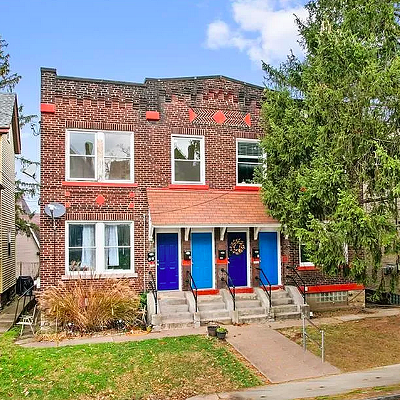The office buildings of Downtown Pittsburgh sport a handful of cryptic plaques that refer to events whose significance they never really explain. My favorite is on Wood Street, where a plaque portentously informs you that it marks the birthplace of William Thaw ... without ever telling you who he is. Pittsburghers are proud of our history, but we don't always feel a need to spell it out for everyone. You don't see the significance of early 20th-century street grades? Well ... I guess you just had to be there. And Pittsburgh being Pittsburgh, probably some of us were.
But the story of this plaque (which is about a floor above street level, at the intersection of Grant and Fifth) dates to the mid 1700s. When Pittsburgh was founded, what is today Grant Street was known as Grant's Hill. It was a sizable lump -- frequently called "the Hump" -- that stretched from Smithfield Street to Ross Street.
In the city's early days, Grant's Hill was seen as a valuable natural asset. On holidays such as the Fourth of July, writes historian Leland Baldwin, "the hoi polloi ate picnic dinners on the greensward." It was a pre-Renaissance Point State Park, minus the faint smell of urine. And as Solon and Elizabeth Buck write in The Planting of Civilization in Western Pennsylvania, the elite made use of the site too. Grant's Hill, the Bucks write, was a place "where well-dressed ladies, gentlemen, and children sauntered about, talking and perhaps taking stock of one another's appearance and clothing."
You don't see much of that behavior on Grant Street today, except maybe at US Steel board meetings. As Pittsburgh attracted new residents, business and industry, the hill, like so many other natural features in the area, was thought of us a liability. You know, like trees and grass.
With a grade of 20 percent, the Hump was hard for horse-drawn wagons and corpulent 19th-century businessmen to climb. As early as the 1800s, the locals recognized the hill would have to go. But in an incident that defines much Grant Street history, taxpayers objected to the cost of removing it.
Eventually, engineers lanced the Hump like a boil, in four separate operations. According to S. Trevor Hadley's Only in Pittsburgh, the first effort came in 1836, when workers lopped 10 feet off the hump, and two more efforts to reduce the "Hump" over the next decade.
Those workers were lowering Grant's Hill even though buildings were built on it, and the results could be jarring: In the late 1840s, the entrance to St. Paul's Cathedral was stranded 15 feet above ground. Parishioners had to get to heaven the hard way: up a flight of wooden steps.
The final effort to remove the Hump came in 1912, when a final 17 feet of the Hump was removed. You can see photos of this final operation in Stefan Lorant's coffee-table book Pittsburgh: The Story of an American City, which sits in many local homes as unmoved and unmoving as the Hump itself.
Scars from the work still remain. When you enter the County Courthouse across the street from the Frick Building, for example, you're actually in what should be the building's basement, rather than the more impressive floor above. And while it's not as easy to tell, when you walk into the Frick Building from Fifth or Forbes avenues, you're going through the basement as well. (It seems a fitting tribute to Frick, one of Pittsburgh's most inflexible corporate titans, that many of us enter and leave the building by what would otherwise be a service entrance.) The Frick was built in 1902, and when the Hump was lowered a decade later, the entrance was dropped to turn the previously below-ground basement into an extended lobby. You can still sort of imagine the lobby's original configuration if you study the Grant Street entrance. The entrance is flanked by two lion statues, which mark where the architects originally planned for people to enter.
So arguably, the significance of the plaque is twofold: It reminds passersby of an engineering project some 75 years in the making, a project that helped make Downtown Pittsburgh what it is today. But it also strikes a slightly defensive note. "Don't blame me for this unorthodox lobby," the building almost seems to be saying. "I'm perfect -- it's everything around me that's changed." And it has.










